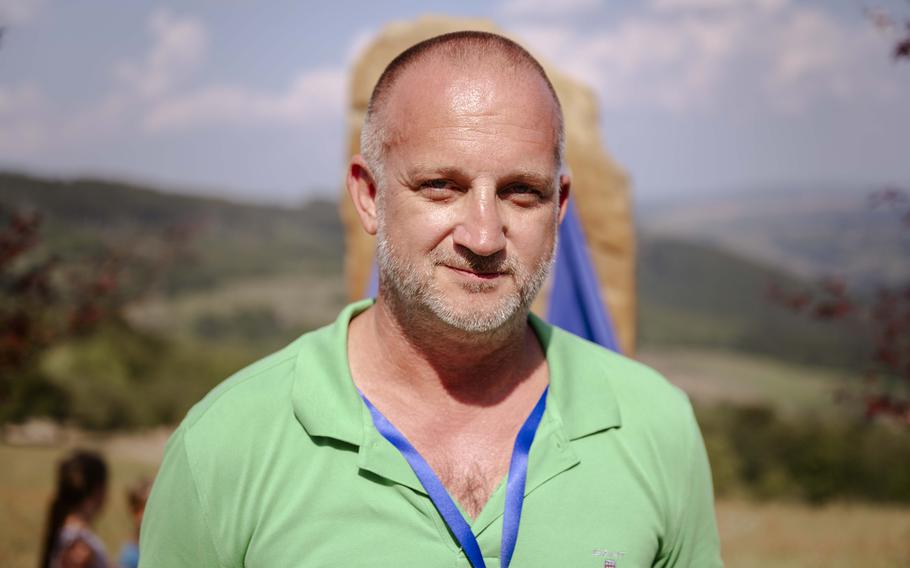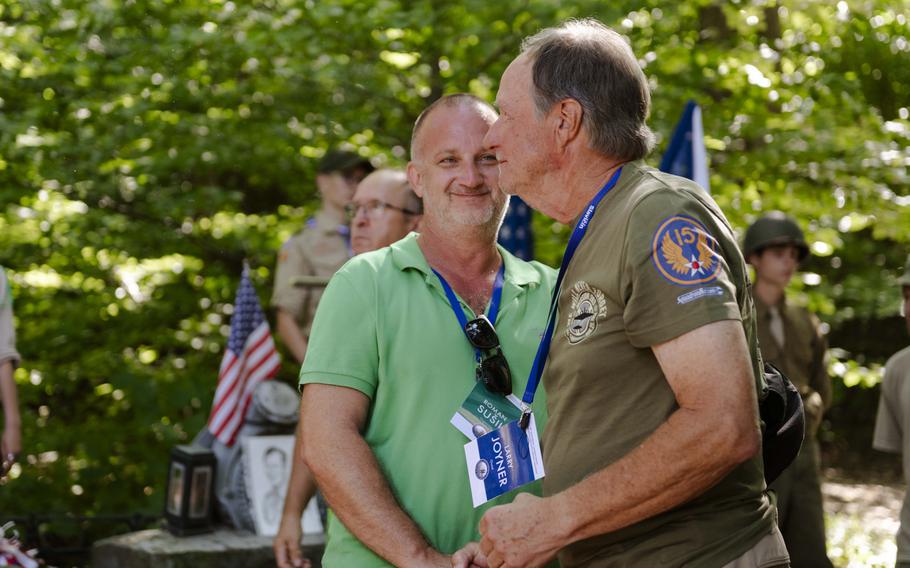
Roman Susil is a resident of the Czech Republic who spearheads the search for families of U.S. airmen who fought in the World War II Battle over the White Carpathians in Czechoslovakia. He is shown standing in front of a memorial to the American service members in Vyskovek, Czech Republic, on Sept. 1, 2024. (Lydia Gordon/Stars and Stripes)
SLAVICIN, Czech Republic — A trip with his parents to a local church four decades ago set Roman Susil on his quest to bring recognition to a group of American service members killed in a little-known World War II air battle.
It was during the 1980s, when his country and nearby Slovakia were still joined as Czechoslovakia under a Soviet-dominated communist dictatorship. At the church, Susil’s parents showed him a grave marker, and it made a lasting impression on him.
“Back then on the headstone, there was nothing,” Susil said. “Only ‘28 Americans shot down on Aug. 29, 1944, buried on Aug. 31. 1944, and exhumed on Sept. 5, 1946.’ That was it. No names.”
The marker honored airmen from four squadrons of the Army’s 15th Air Force, 2nd Bombardment Group who fought in the Battle over the White Carpathians, officially known as Mission 263.
On the morning of the battle, the four squadrons composed of B-24 Liberators and B-17 Flying Fortresses departed from Foggia, Italy, to destroy a mass of Nazi armaments. Only three squadrons returned.
Unbeknownst to the Americans, Nazi forces had been warned of their arrival and mimicked American escort flyers to stave off detection. By the time the rear squadron became aware of the deception, it was too late.
All eight planes in the 20th Bombardment Squadron formation were shot down, along with two from the 429th and 49th squadrons. In all, 41 Americans died in the battle.
Suppression of information in Cold War-era Czechoslovakia left many generations in the dark about the WWII combat in their lands.
But five years after the 1989 Velvet Revolution toppled the communist regime in Prague, a new headstone was erected at the Slavicin church, this one bearing the names of the 28 American airmen.
From that point, the search for their family members commenced. But in the days before social media, all he had to work with was signatures from a handful of veterans who showed up at various commemorations.
Since 2004, though, his efforts to research the airmen involved in the Battle over the White Carpathians and give closure to their loved ones have been greatly extended.
That year, he connected with “Tail End Charlie” navigator 2nd Lt. Loy Dickinson, and after exchanging contacts, they began writing letters. He also started online message boards and created a Facebook group.
Dickinson shared the letters with his fellow surviving crew members, including Staff Sgt. Joseph Owsianik, a right waist gunner with Tail End Charlie in the 20th Bombardment Group who had been taken prisoner by the Nazis after the downing of his aircraft.
“We became friends. … He was like a grandfather to me,” Susil said of Owsianik.
In 2007, Owsianik made a return visit, and Willi Reschke, a German who had fought in the battle, was in attendance. Owsianik’s request to have Susil accompany him to hug his former enemy pushed the Czech to continue his search, he said.
All told, Susil has since been in touch with over 40 families.
“My father somehow came across Roman’s name and we joined (his) Facebook group, which is what started everything,” said Air Force Lt. Col. Sasha Heath, the great-niece of “Lovely Ladies” co-pilot 2nd Lt. Theo Heath, one of the 28 Americans buried in a mass grave in 1944.

Roman Susil, left, shakes hands with Larry Joyner at a ceremony in Sanov, Czech Republic on Sept. 1, 2024, marking the 80th anniversary of the Battle over the White Carpathians. The obscure World War II battle in Czechoslovakia resulted in the deaths of 41 Americans. (Lydia Gordon/Stars and Stripes)
Susil is not alone in his efforts. He works with Vlastimil Hela, a local author and historian, and Anton Bonko, their logistics head, to organize the annual commemorations and share information about the battle.
Other residents take to the White Carpathian Mountains with metal detectors in search of crash remains and artifacts, hoping to return items to families or display them in local history museums.
Grave sites and memorials have also been built and maintained by townspeople. Susil said he has two reasons for keep on going. “The first is to show the American families that we haven’t forgotten the sacrifice of those men,” he said. “The second is to show the younger generations what the war is and what the war was and not to repeat it again.”